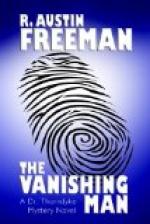“With the result that there was dredged up out of a pond near St. Mary Cray, in Kent, a right thigh-bone. There is a slight clue to identity in respect of this bone, since the head of it has a small patch of what is called ’eburnation’—that is a sort of porcelain-like polish that occurs on the parts of bones that form a joint when the natural covering of cartilage is destroyed by disease. It is produced by the unprotected surface of one bone grinding against the similarly unprotected surface of another.”
“And how,” Mr. Bellingham asked, “would that help the identification?”
“It would indicate,” replied Thorndyke, “that the deceased had probably suffered from rheumatoid arthritis—what is commonly known as rheumatic gout—and he would probably have limped slightly and complained of some pain in the right hip.”
“I am afraid that doesn’t help us much,” said Mr. Bellingham; “for, you see, John had a pretty pronounced limp from another cause, an old injury to his left ankle; and as to complaining of pain—well, he was a hardy old fellow and not much given to making complaints of any kind. But don’t let me interrupt you.”
“The next discovery,” continued Thorndyke, “was made near Lee, by the police this time. They seem to have developed sudden activity in the matter, and in searching the neighbourhood of West Kent they dragged out of a pond near Lee the bones of a right foot. Now, if it had been the left instead of the right we might have had a clue, as I understand that your brother had fractured his left ankle, and there might have been some traces of the injury on the foot itself.”
“Yes,” said Mr. Bellingham, “I suppose there might. The injury was described as a Pott’s fracture.”
“Exactly. Well, now, after this discovery at Lee it seems that the police set on foot a systematic search of all the ponds and small pieces of water around London, and on the twenty-third, they found in the Cuckoo Pits in Epping Forest, not far from Woodford, the bones of a right arm (including those of the shoulder, as before), which seem to be part of the same body.”
“Yes,” said Mr. Bellingham, “I heard of that. Quite close to my old house. Horrible! horrible! It gave me the shudders to think of it—to think that poor old John may have been waylaid and murdered when he was actually coming to see me. He may even have got into the grounds by the back gate, if it was left unfastened, and been followed in there and murdered. You remember that a scarab from his watch-chain was found there? But is it clear that this arm was the fellow of the arm that was found at Sidcup?”
“It seems to agree in character and dimensions,” said Thorndyke, “and the agreement is strongly supported by a discovery that was made two days later.”
“What is that?” Mr. Bellingham demanded.




